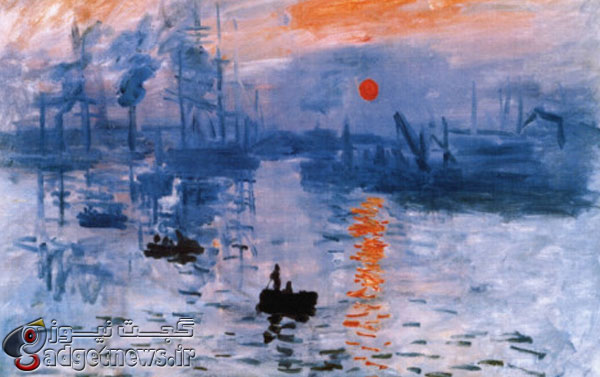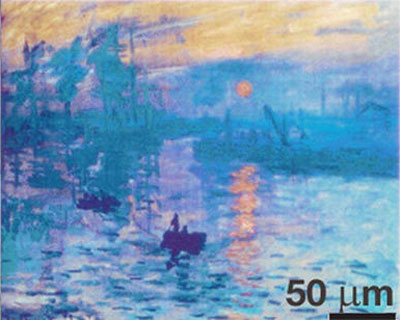
اين بار علم نانو در خلق آثار هنري وارد شده و مهندسي نانو به مهندسان اين اجازه را داده تا کوچکترين اثر هنري جهان را با اندازه 300 ميکرومتر خلق کنند . در ادامه شاهد توضيحات بيشتر در خصوص اين اثر هنري و خلق آن باشيد .
این اثر هنری که نسخهای از نقاشی قرن نوزدهم کلود مونه موسوم به «امپرسیون، طلوع خورشید» است، توسط محققان دانشگاه فناوری و طراحی سنگاپور ساخته شده است.

در این اثر، محققان بجای رنگ روغن از پالتی از ستونهای سیلیکونی مقیاس نانو با سرهای آلومینیومی استفاده کردند. هنگامی که نور به این ستونها تابیده میشود، ریزموجهایی از الکترونها را ایجاد میکنند که به نوبه خود نورهای رنگی از یک فرکانس ویژه را منتشر میکنند.
دانشمندان همچنین پیکسلها را از چهار ستون ساخته و اندازه و فاصله آنها را برای تولید حدود 300 رنگ مختلف تغییر دادند تا در نهایت نقاشی مونه ایجاد شود. این پیکسلهای کوچک علاوه بر بازسازی نقاشیهای معروف، همچنین میتوانند برای ذخیره اطلاعات یا ایجاد برچسبهای ایمنی کوچک بر روی اجسام فیزیکی مورد استفاده قرار گیرند.
منبع : cnet
Claude Monet, painter of light, had his oils; researchers at the Singapore University of Technology and Design have nanoscale silicon pillars. A reproduction of Monet’s Impression, Sunrise has been completed by a team led by Joel Wang, but there’s a more immediately noticeable difference than choice of medium: Wang’s team’s reproduction is just 300 micrometers wide — one third of a millimetre.
The tiny silicon pillars used to produce the work are where the colour comes from. More specifically, each pillar is topped with an aluminium disc, ranging from 80 to 220 nanometers across. These act as tunable resonators. When light hits the disc, it hits the oscillating surface electrons, and reflects back the frequency that matches that oscillation. This is called plasmon resonance, first harnessed by Yang et al in 2012 for a palette of 15 colours in gold- and silver-topped pillars.
The researchers used the plasmon resonance to create 100 colours by mixing pillars of varying widths at a distance of 400 nanometers from pillar centre to pillar centre. Then, by varying the distance between pillars of the same width, they created an additional 200 colours, for a final colour palette of 300 colours.
In addition, the aluminium-topped pillars are a lot more stable than the previous method; oxidisation rendered the silver discs unusable after about a week.
To demonstrate what they could do with their new discovery, the team painstakingly put together the image above, with the idea that it could be implemented in printing applications; in particular, low-cost, high-resolution plasmonic colour printing that could be used in security tagging, cryptography and information storage.
The full paper, “Plasmonic Color Palettes for Photorealistic Printing with Aluminium Nanostructures”, can be found online in the journal Nano Letters.
 گجت نیوز آخرین اخبار تکنولوژی، علم و خودرو
گجت نیوز آخرین اخبار تکنولوژی، علم و خودرو 





